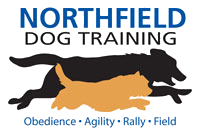Recommended Equipment
In order to make the first day of class as productive as possible, we would like to pass along equipment suggestions to reduce the amount of time we need to spend in class discussing it.
For the Intro to Retriever Class, view the recommended equipment here.
Collars
The type of collar you use depends on your dog’s personality and your ability to control the dog. Both you and your dog need to feel comfortable with the collar you choose to use. If you have difficulty controlling your dog with a regular buckle collar, we suggest that you use either a pinch collar or a Gentle Leader head collar.
Although choke collars have been used for decades in obedience classes, we do not recommend them. They are frequently ineffective –i.e. most dogs continue to pull just as hard even while wearing these collars. In addition, many dogs begin gagging and choking from the collar’s tightness even while continuing to pull hard. Leash jerks that are strong enough to control the dog can cause damage to the dog’s trachea.
We know that the pinch, or prong, collar looks ugly. It is, however, far more humane than a choke collar, and it usually gives you significant control immediately. It won’t choke or puncture your dog’s neck, or hurt your dog in any way, or cause him to gag. Instead it closes uniformly around the dog’s neck and is effective without the handler having to correct or jerk the dog. Most dogs adjust to it immediately. It should be worn high on the dog’s neck, directly behind the dog’s ears. Links can be added to the collar as your puppy grows. We usually fit larger, hard-to-control puppies with pinch collars only when they are at least 4 months old.
The Gentle Leader and Haltis are brands of head collar. They have two parts, one that goes around the dog’s neck right behind the skull, the other that goes around the dog’s nose. While the head collars can reduce pulling even more than a pinch collar, they usually require more of an adjustment period, since most dogs aren’t used to having something around the nose. Many dogs never really adjust to them and try to get them off their nose any time you use it. For some dogs with reactivity or aggression issues, they can be a better choice than a pinch collar.
Leashes
We prefer a short (three to four feet) leather leash for dogs that pull. Nylon leashes can burn your hand if your dog pulls hard on his leash. Leather leashes are comfortable and provide good traction.
Retractable leads are very convenient to use on walks once you have your dog under basic control. However they are not appropriate substitutes for training leashes (see above) in obedience classes or training situations.
We generally spend the first 10-15 minutes of the first week of Jumpstart class helping people with equipment needs. We sell pinch collars here at Northfield Dog Training. We also have a variety of quality leather leashes. Please bring cash or your checkbook to pay for your equipment.
Prices (sales tax included)
Medium pinch collar $18.00
Small pinch collar $16.00
Extra pinch collar links $2/each
Leather Leashes $7-$17
(note: prices subject to change)
